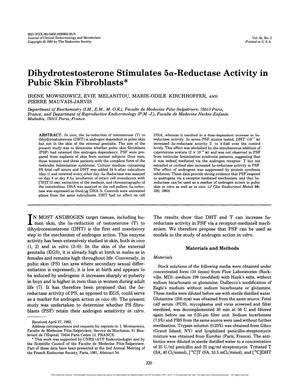Dihydrotestosterone Stimulates 5α-Reductase Activity in Pubic Skin Fibroblasts
February 1983
in “
The Journal of clinical endocrinology and metabolism/Journal of clinical endocrinology & metabolism
”
dihydrotestosterone 5α-reductase testosterone androgen receptor cyproterone acetate estradiol cortisol protein synthesis pubic skin fibroblasts testicular feminization syndrome DHT 5-alpha reductase T androgen receptor cyproterone acetate estradiol cortisol protein synthesis PSF testicular feminization syndrome

TLDR Dihydrotestosterone increases the activity of an enzyme in pubic skin cells that converts testosterone to dihydrotestosterone.
The study investigated whether the androgen dependency of 5α-reductase activity, which is responsible for converting testosterone (T) to dihydrotestosterone (DHT), is retained in pubic skin fibroblasts (PSF). The PSF were obtained from seven normal subjects (four men and three women) and three patients with testicular feminization syndrome. The fibroblasts were treated with DHT and the 5α-reductase activity was measured. The results showed that DHT stimulated a 2- to 4-fold increase in 5α-reductase activity in PSF from normal subjects, an effect that was blocked by cyproterone acetate, indicating it was mediated by the androgen receptor. This effect was not seen in PSF from patients with testicular feminization syndrome. Testosterone also increased 5α-reductase activity, but estradiol and cortisol did not. The increase in 5α-reductase activity was dependent on protein synthesis. These findings suggest that PSF respond to androgens through a receptor-mediated mechanism and that 5α-reductase can be used as a marker for androgen action in pubic skin both in vitro and in vivo.



